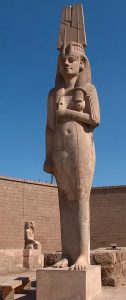Ancient Egypt Akhmim is a town that is located on the east bank of the Nile opposite modern city of Sohag. It was called by various names like Ipu or Khent-min by the ancient Egyptians. To the Coptics, it was Khmin or Shmin, and so the Greeks called it Khemmis.
 Akhmim’s main attraction is the statue of Meryetamun that is 11 meters high. Meryetamun was the daughter of Ramses II who even became his wife after her mother, Nefertari, died. The necropolis at Akhmim has never been systematically excavated, although recent discoveries include five tombs dating to the Old Kingdom where a number of sarcophagi and plaques have been found.
Akhmim’s main attraction is the statue of Meryetamun that is 11 meters high. Meryetamun was the daughter of Ramses II who even became his wife after her mother, Nefertari, died. The necropolis at Akhmim has never been systematically excavated, although recent discoveries include five tombs dating to the Old Kingdom where a number of sarcophagi and plaques have been found.
With a rich cultural past, Akhmim has numbers of mosques and Coptic churches as its ancient treasure. But apart from this historical heritage, Akhmim also has a number of cotton mills and a very lively fascinating bazaar.
A number of rock-cut tombs of various dates are found in the area, particularly at El-Hawawish, northeast of Akhmim and at El-Salamuni. Some of them are decorated with painted circular zodiacs. These tombs belong to the officials of the name from the late Old Kingdom and the early Middle Kingdom. Apparently, it is evident from these tombs that these local rulers acquired a great deal of wealth and some power.
Akhmim Excavations
In 1981, part of a temple with a monumental gate believed to date to the Graeco-Roman Period was unearthed during building works on the north-eastern edge of the town.
During excavations, Archaeologists found several statue fragments of Rameses II. They also found out a beautiful colossal statue of the king’s daughter and consort, Meryetamun, a rich past heritage. This statue is now re-erected in the center of the area which has become an open-air museum, several meters below the modern ground level.
Another attraction of Akhmim and a place worth visiting is the Necropolis of El- Hawawish. It was the burial ground of the governors of the area belonging to 4th to the 11 dynasties.
To preserve this rich cultural heritage, the Egyptian government has agreed to allocate EGP 5 million in order to begin proper excavation of the site. This will include relocating the old Muslim cemetery which partly covers the area and the construction of a new one.